Characterisation of Extreme Precipitation Events in the Pyrenees: From the Local to the Synoptic Scale
Abstract
1. Introduction
2. Data and Methods
2.1. Data
2.2. Analysis of Extreme Events and Definition of Torrential Events
- ξ > 0 giving the heavy-tailed (Frechet) case;
- ξ = 0 giving the light-tailed (Gumbel) case. For this case:
- ξ < 0 giving the bounded-tailed (Weibull) case.
2.3. Synoptic Classification Approach and Circulation Composites
2.4. Hysplit Model
3. Results and Discussion
3.1. Maximum Daily Precipitation for Different Return Periods
3.2. Characterisation of Torrential Events: Spatial Distribution and Seasonality
3.3. Large-Scale Attribution of Torrential Events
3.4. Backward Trajectory Analysis
4. Conclusions
Supplementary Materials
Author Contributions
Funding
Institutional Review Board Statement
Informed Consent Statement
Data Availability Statement
Acknowledgments
Conflicts of Interest
References
- Beguería, S.; Vicente-Serrano, S.M.; López-Moreno, J.I.; García-Ruiz, J.M. Annual and seasonal mapping of peak intensity, magnitude and duration of extreme precipitation events across a climatic gradient, northeast Spain. Int. J. Clim. 2009, 29, 1759–1779. [Google Scholar] [CrossRef]
- Vicente-Serrano, S.M.; Beguería, S.; López-Moreno, J.I.; El Kenawy, A.M.; Angulo-Martínez, M. Daily atmospheric circulation events and extreme precipitation risk in northeast Spain: Role of the North Atlantic Oscillation, the Western Mediterranean Oscillation, and the Mediterranean Oscillation. J. Geophys. Res. 2009, 114, D08106. [Google Scholar] [CrossRef]
- Buisan, S.T.; Saz, M.A.; López-Moreno, J.I. Spatial and temporal variability of winter snow and precipitation days in the western and central Spanish Pyrenees. Int. J. Clim. 2015, 35, 259–274. [Google Scholar] [CrossRef]
- García-Sellés, C.; Peña, J.C.; Martí, G.; Oller, P.; Martínez, P. WeMOI and NAOi influence on major avalanche activity in the Eastern Pyrenees. Cold Reg. Sci. Technol. 2010, 64, 137–145. [Google Scholar] [CrossRef]
- Oller, P.; Muntán, E.; García-Sellés, C.; Furdada, G.; Baeza, C.; Angulo, C. Characterizing major avalanche episodes in space and time in the twentieth and early twenty-first centuries in the Catalan Pyrenees. Cold Reg. Sci. Technol. 2015, 110, 129–148. [Google Scholar] [CrossRef][Green Version]
- Furdada, G.; Margalef, A.; Trapero, L.; Pons, M.; Areny, F.; Baró, M.; Reyes, A.; Guinau, M. The Avalanche of Les Fonts d’Arinsal (Andorra): An Example of a Pure Powder, Dry Snow Avalanche. Geosciences 2020, 10, 126. [Google Scholar] [CrossRef]
- Esteban, P.; Jones, P.D.; Martín-Vide, J.; Mases, M. Atmospheric circulation patterns related to heavy snowfall days in Andorra, Pyrenees. Int. J. Clim. 2005, 25, 319–329. [Google Scholar] [CrossRef]
- Buisan, S.; López-Moreno, J.; Saz, M.; Kochendorfer, J. Impact of weather type variability on winter precipitation, temperature and annual snowpack in the Spanish Pyrenees. Clim. Res. 2016, 69, 79–92. [Google Scholar] [CrossRef]
- Navarro-Serrano, F.; López-Moreno, J.I. Spatio-temporal analysis of snowfall events in the spanish Pyrenees and their relationship to atmospheric circulation. Cuadernos Investig. Geográf. 2017, 43, 233–254. [Google Scholar] [CrossRef]
- Trapero, L.; Bech, J.; Lorente, J. Numerical modelling of heavy precipitation events over Eastern Pyrenees: Analysis of orographic effects. Atmos. Res. 2013, 123, 368–383. [Google Scholar] [CrossRef]
- Trapero, L.; Bech, J.; Duffourg, F.; Esteban, P.; Lorente, J. Mesoscale numerical analysis of the historical November 1982 heavy precipitation event over Andorra (Eastern Pyrenees). Nat. Hazards Earth Syst. Sci. 2013, 13, 2969–2990. [Google Scholar] [CrossRef]
- Vicente-Serrano, S.M.; Zabalza-Martínez, J.; Borràs, G.; López-Moreno, J.I.; Pla, E.; Pascual, D.; Savé, R.; Biel, C.; Funes, I.; Azorin-Molina, C.; et al. Extreme hydrological events and the influence of reservoirs in a highly regulated river basin of northeastern Spain. J. Hydrol. Reg. Stud. 2017, 12, 13–32. [Google Scholar] [CrossRef]
- Madsen, H.; Lawrence, D.; Lang, M.; Martinkova, M.; Kjeldsen, T.R. Review of trend analysis and climate change projections of extreme precipitation and floods in Europe. J. Hydrol. 2014, 519, 3634–3650. [Google Scholar] [CrossRef]
- Insua-Costa, D.; Lemus-Cánovas, M.; Miguez-Macho, G.; Llasat, M.C. Climatology and ranking of hazardous precipitation events in the western Mediterranean area. Atmos. Res. 2021, 255, 105521. [Google Scholar] [CrossRef]
- Lemus-Canovas, M.; Lopez-Bustins, J.A.; Martin-Vide, J.; Royé, D. synoptReg: An R package for computing a synoptic climate classification and a spatial regionalization of environmental data. Environ. Model. Softw. 2019, 118, 114–119. [Google Scholar] [CrossRef]
- Lagouvardos, K.; Dafis, S.; Giannaros, C.; Karagiannidis, A.; Kotroni, V. Investigating the Role of Extreme Synoptic Patterns and Complex Topography During Two Heavy Rainfall Events in Crete in February 2019. Climate 2020, 8, 87. [Google Scholar] [CrossRef]
- Esteban, P.; Ninyerola, M.; Prohom, M. Spatial modelling of air temperature and precipitation for Andorra (Pyrenees) from daily circulation patterns. In Proceedings of the Theoretical and Applied Climatology; Springer: Wien, Austria, 2009; Volume 96, pp. 43–56. [Google Scholar]
- Lemus-Canovas, M.; Lopez-Bustins, J.A.; Trapero, L.; Martin-Vide, J. Combining circulation weather types and daily precipitation modelling to derive climatic precipitation regions in the Pyrenees. Atmos. Res. 2019, 220, 181–193. [Google Scholar] [CrossRef]
- Trigo, R.M.; DaCamara, C.C. Circulation weather types and their influence on the precipitation regime in Portugal. Int. J. Clim. 2000, 20, 1559–1581. [Google Scholar] [CrossRef]
- Lorenzo, M.N.; Taboada, J.J.; Gimeno, L. Links between circulation weather types and teleconnection patterns and their influence on precipitation patterns in Galicia (NW Spain). Int. J. Clim. 2008, 28, 1493–1505. [Google Scholar] [CrossRef]
- Cortesi, N.; Gonzalez-Hidalgo, J.C.; Trigo, R.M.; Ramos, A.M. Weather types and spatial variability of precipitation in the Iberian Peninsula. Int. J. Clim. 2014, 34, 2661–2677. [Google Scholar] [CrossRef]
- Ramos, A.M.; Cortesi, N.; Trigo, R.M. Circulation weather types and spatial variability of daily precipitation in the Iberian Peninsula. Front. Earth Sci. 2014, 2, 25. [Google Scholar] [CrossRef]
- Lemus-Canovas, M.; Ninyerola, M.; Lopez-Bustins, J.A.; Manguan, S.; Garcia-Sellés, C. A mixed application of an objective synoptic classification and spatial regression models for deriving winter precipitation regimes in the Eastern Pyrenees. Int. J. Clim. 2019, 39, 2244–2259. [Google Scholar] [CrossRef]
- Jones, P.D.; Hulme, M.; Briffa, K.R. A comparison of Lamb circulation types with an objective classification scheme. Int. J. Clim. 1993, 13, 655–663. [Google Scholar] [CrossRef]
- Carro-Calvo, L.; Ordóñez, C.; García-Herrera, R.; Schnell, J.L. Spatial clustering and meteorological drivers of summer ozone in Europe. Atmos. Environ. 2017, 167, 496–510. [Google Scholar] [CrossRef]
- Martin-Vide, J.; Sanchez-Lorenzo, A.; Lopez-Bustins, J.A.; Cordobilla, M.J.; Garcia-Manuel, A.; Raso, J.M. Torrential rainfall in northeast of the Iberian Peninsula: Synoptic patterns and WeMO influence. Adv. Sci. Res. 2008, 2, 99–105. [Google Scholar] [CrossRef]
- Lopez-Bustins, J.A.; Martin-Vide, J.; Sanchez-Lorenzo, A. Iberia winter rainfall trends based upon changes in teleconnection and circulation patterns. Glob. Planet. Chang. 2008, 63, 171–176. [Google Scholar] [CrossRef]
- Sanchez-Lorenzo, A.; Calbó, J.; Martin-Vide, J.; Garcia-Manuel, A.; García-Soriano, G.; Beck, C. Winter “weekend effect” in southern Europe and its connections with periodicities in atmospheric dynamics. Geophys. Res. Lett. 2008, 35, L15711. [Google Scholar] [CrossRef]
- Nishiyama, K.; Endo, S.; Jinno, K.; Bertacchi Uvo, C.; Olsson, J.; Berndtsson, R. Identification of typical synoptic patterns causing heavy rainfall in the rainy season in Japan by a Self-Organizing Map. Atmos. Res. 2007, 83, 185–200. [Google Scholar] [CrossRef]
- Meseguer-Ruiz, O.; Ponce-Philimon, P.I.; Baltazar, A.; Guijarro, J.A.; Serrano-Notivoli, R.; Olcina Cantos, J.; Martin-Vide, J.; Sarricolea, P. Synoptic attributions of extreme precipitation in the Atacama Desert (Chile). Clim. Dyn. 2020, 55, 3431–3444. [Google Scholar] [CrossRef]
- Kunkel, K.E.; Stevens, S.E.; Stevens, L.E.; Karl, T.R. Observed Climatological Relationships of Extreme Daily Precipitation Events With Precipitable Water and Vertical Velocity in the Contiguous United States. Geophys. Res. Lett. 2020, 47, e2019GL086721. [Google Scholar] [CrossRef]
- Sillmann, J.; Kharin, V.V.; Zwiers, F.W.; Zhang, X.; Bronaugh, D. Climate extremes indices in the CMIP5 multimodel ensemble: Part 2. Future climate projections. J. Geophys. Res. Atmos. 2013, 118, 2473–2493. [Google Scholar] [CrossRef]
- Cuadrat, J.M.; Serrano-Notivoli, R.; Tejedor, E.; Saz, M.Á.; Prohom, M.; Cunillera, J.; Llabrés, A.; Trapero, L.; Pons, M.; López-Moreno, J.I.; et al. CLIMPY: Climate of the Pyrenees. Zenodo 2020. [Google Scholar] [CrossRef]
- Serrano-Notivoli, R.; Beguería, S.; Saz, M.Á.; Longares, L.A.; De Luis, M. SPREAD: A high-resolution daily gridded precipitation dataset for Spain—An extreme events frequency and intensity overview. Earth Syst. Sci. Data 2017, 9, 721–738. [Google Scholar] [CrossRef]
- Hersbach, H.; Bell, B.; Berrisford, P.; Hirahara, S.; Horányi, A.; Muñoz-Sabater, J.; Nicolas, J.; Peubey, C.; Radu, R.; Schepers, D.; et al. The ERA5 global reanalysis. Q. J. R. Meteorol. Soc. 2020, 146, 1999–2049. [Google Scholar] [CrossRef]
- Stein, A.F.; Draxler, R.R.; Rolph, G.D.; Stunder, B.J.B.; Cohen, M.D.; Ngan, F. Noaa’s hysplit atmospheric transport and dispersion modeling system. Bull. Am. Meteorol. Soc. 2015, 96, 2059–2077. [Google Scholar] [CrossRef]
- Kalnay, E.; Kanamitsu, M.; Kistler, R.; Collins, W.; Deaven, D.; Gandin, L.; Iredell, M.; Saha, S.; White, G.; Woollen, J.; et al. The NCEP/NCAR 40-Year Reanalysis Project. Bull. Am. Meteorol. Soc. 1996, 77, 437–472. [Google Scholar] [CrossRef]
- Martin-Vide, J.; Lopez-Bustins, J.-A. The Western Mediterranean Oscillation and rainfall in the Iberian Peninsula. Int. J. Clim. 2006, 26, 1455–1475. [Google Scholar] [CrossRef]
- Conte, M.; Giuffrida, A.; Tedesco, S. Mediterranean Oscillation: Impact on Precipitation and Hydrology in Italy. Conf. Clim. Water 1989, 9, 121–137. [Google Scholar]
- Redolat, D.; Monjo, R.; Lopez-Bustins, J.A.; Martin-Vide, J. Upper-Level Mediterranean Oscillation index and seasonal variability of rainfall and temperature. Theor. Appl. Clim. 2019, 135, 1059–1077. [Google Scholar] [CrossRef]
- Hurrell, J.W. Decadal trends in the North Atlantic oscillation: Regional temperatures and precipitation. Science 1995, 269, 676–679. [Google Scholar] [CrossRef]
- Llasat, M.-C. An objective classification of rainfall events on the basis of their convective features: Application to rainfall intensity in the northeast of Spain. Int. J. Clim. 2001, 21, 1385–1400. [Google Scholar] [CrossRef]
- Lopez-Bustins, J.; Arbiol-Roca, L.; Martin-Vide, J.; Barrera-Escoda, A.; Prohom, M. Intra-annual variability of the Western Mediterranean Oscillation (WeMO) and occurrence of extreme torrential precipitation in Catalonia (NE Iberia). Nat. Hazards Earth Syst. Sci. 2020, 20, 2483–2501. [Google Scholar] [CrossRef]
- De Luis, M.; González-Hidalgo, J.C.; Raventós, J. Effects of fire and torrential rainfall on erosion in a Mediterranean gorse community. Land Degrad. Dev. 2003, 14, 203–213. [Google Scholar] [CrossRef]
- Cattell, R.B. The scree test for the number of factors. Multivar. Behav. Res. 1966. [Google Scholar] [CrossRef]
- Richman, M.B. Rotation of principal components. J. Clim. 1986, 6, 293–335. [Google Scholar] [CrossRef]
- Lavers, D.A.; Villarini, G.; Allan, R.P.; Wood, E.F.; Wade, A.J. The detection of atmospheric rivers in atmospheric reanalyses and their links to British winter floods and the large-scale climatic circulation. J. Geophys. Res. Atmos. 2012, 117, 117. [Google Scholar] [CrossRef]
- Gustafsson, M.; Rayner, D.; Chen, D. Extreme rainfall events in southern Sweden: Where does the moisture come from? Tellus A Dyn. Meteorol. Oceanogr. 2010, 62, 605–616. [Google Scholar] [CrossRef]
- Fleming, Z.L.; Monks, P.S.; Manning, A.J. Review: Untangling the influence of air-mass history in interpreting observed atmospheric composition. Atmos. Res. 2012, 104–105, 1–39. [Google Scholar] [CrossRef]
- Martin-Vide, J. Spatial distribution of a daily precipitation concentration index in peninsular Spain. Int. J. Clim. 2004, 24, 959–971. [Google Scholar] [CrossRef]
- Lopez-Bustins, J.A.; Lemus-Canovas, M. The influence of the Western Mediterranean Oscillation upon the spatio-temporal variability of precipitation over Catalonia (northeastern of the Iberian Peninsula). Atmos. Res. 2020, 236, 104819. [Google Scholar] [CrossRef]
- de Luis, M.; Brunetti, M.; Gonzalez-Hidalgo, J.C.; Longares, L.A.; Martin-Vide, J. Changes in seasonal precipitation in the Iberian Peninsula during 1946-2005. Glob. Planet. Chang. 2010, 74, 27–33. [Google Scholar] [CrossRef]
- Merino, A.; Fernández-Vaquero, M.; López, L.; Fernández-González, S.; Hermida, L.; Sánchez, J.L.; García-Ortega, E.; Gascón, E. Large-scale patterns of daily precipitation extremes on the Iberian Peninsula. Int. J. Clim. 2016, 36, 3873–3891. [Google Scholar] [CrossRef]
- Pérez-Zanón, N.; Casas-Castillo, M.C.; Peña, J.C.; Aran, M.; Rodríguez-Solà, R.; Redaño, A.; Solé, G. Analysis of synoptic patterns in relationship with severe rainfall events in the Ebre Observatory (Catalonia). Acta Geophys. 2018, 66, 405–414. [Google Scholar] [CrossRef]
- Bonsoms, J.; Gonzalez, S.; Prohom, M.; Esteban, P.; Salvador-Franch, F.; López-Moreno, J.I.; Oliva, M. Spatio-temporal patterns of snow in the Catalan Pyrenees (NE Iberia). Int. J. Clim. 2021. Under review. [Google Scholar] [CrossRef]
- Insua-Costa, D.; Miguez-Macho, G.; Llasat, C. Local and remote moisture sources for extreme precipitation: A study of the two catastrophic 1982 western Mediterranean episodes. Hydrol. Earth Syst. Sci. 2019, 23, 3885–3900. [Google Scholar] [CrossRef]
- Pineda, N.; Esteban, P.; Trapero, L.; Soler, X.; Beck, C. Circulation types related to lightning activity over Catalonia and the Principality of Andorra. Phys. Chem. Earth 2010, 35, 469–476. [Google Scholar] [CrossRef]
- Martinez-Artigas, J.; Lemus-Canovas, M.; Lopez-Bustins, J.A. Precipitation in peninsular Spain: Influence of teleconnection indices and spatial regionalisation. Int. J. Clim. 2021, 41, E1320–E1335. [Google Scholar] [CrossRef]
- Rodó, X.; Baert, E.; Comin, F.A. Variations in seasonal rainfall in Southern Europe during the present century: Relationships with the North Atlantic Oscillation and the El Niño-Southern Oscillation. Clim. Dyn. 1997, 13, 275–284. [Google Scholar] [CrossRef]
- Esteban, P.; Soler, X.; Prohom, M.; Planchon, O. La Distribución de la Precipitación a Través del Índice NAO. El Efecto del Relieve a Escala Local: El Pirineo Oriental; Publicaciones de la Sociedad Española de Climatología: Palma de Mallorca, Spain, 2002; pp. 25–34. [Google Scholar]
- Pastor, F.; Valiente, J.A.; Estrela, M.J. Sea surface temperature and torrential rains in the Valencia region: Modelling the role of recharge areas. Hazards Earth Syst. Sci. 2015, 15, 1677–1693. [Google Scholar] [CrossRef]
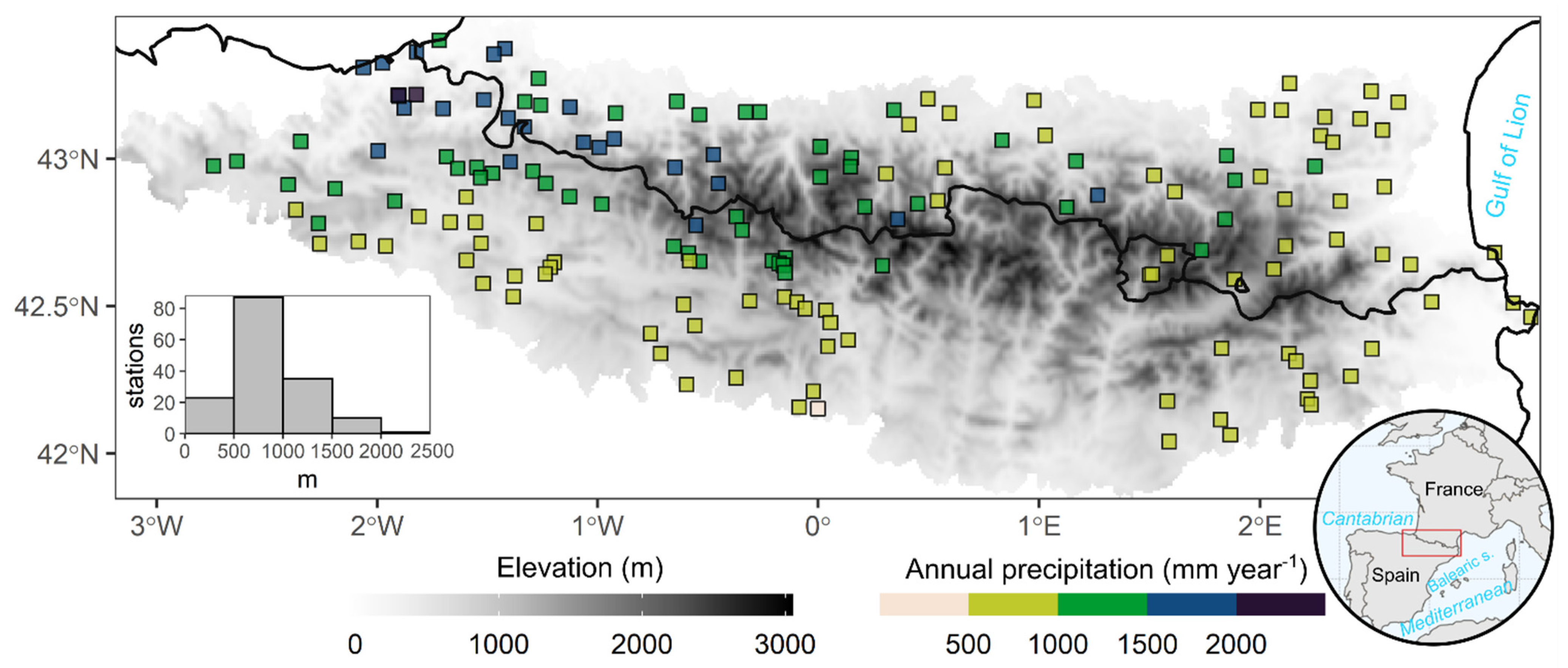
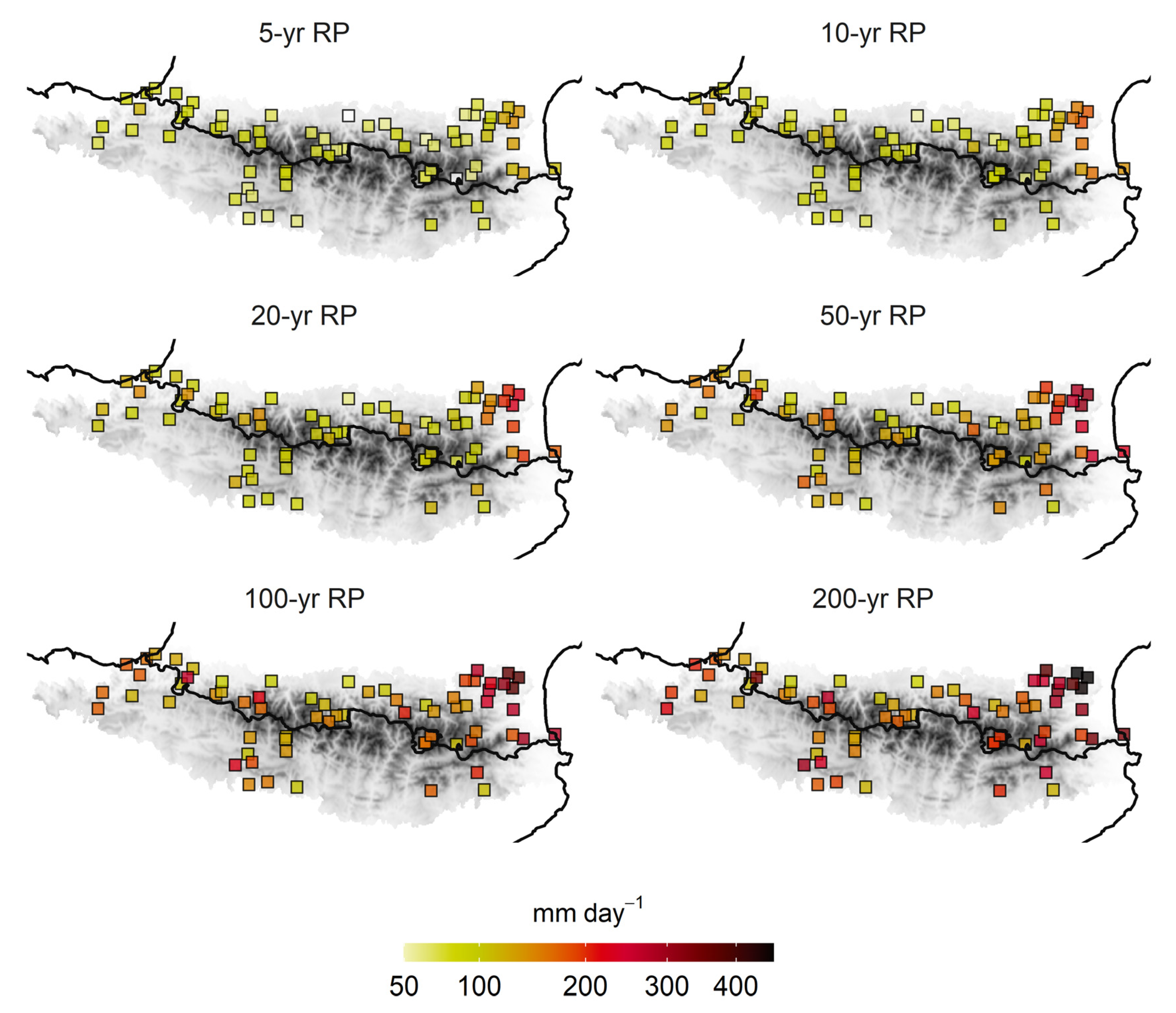
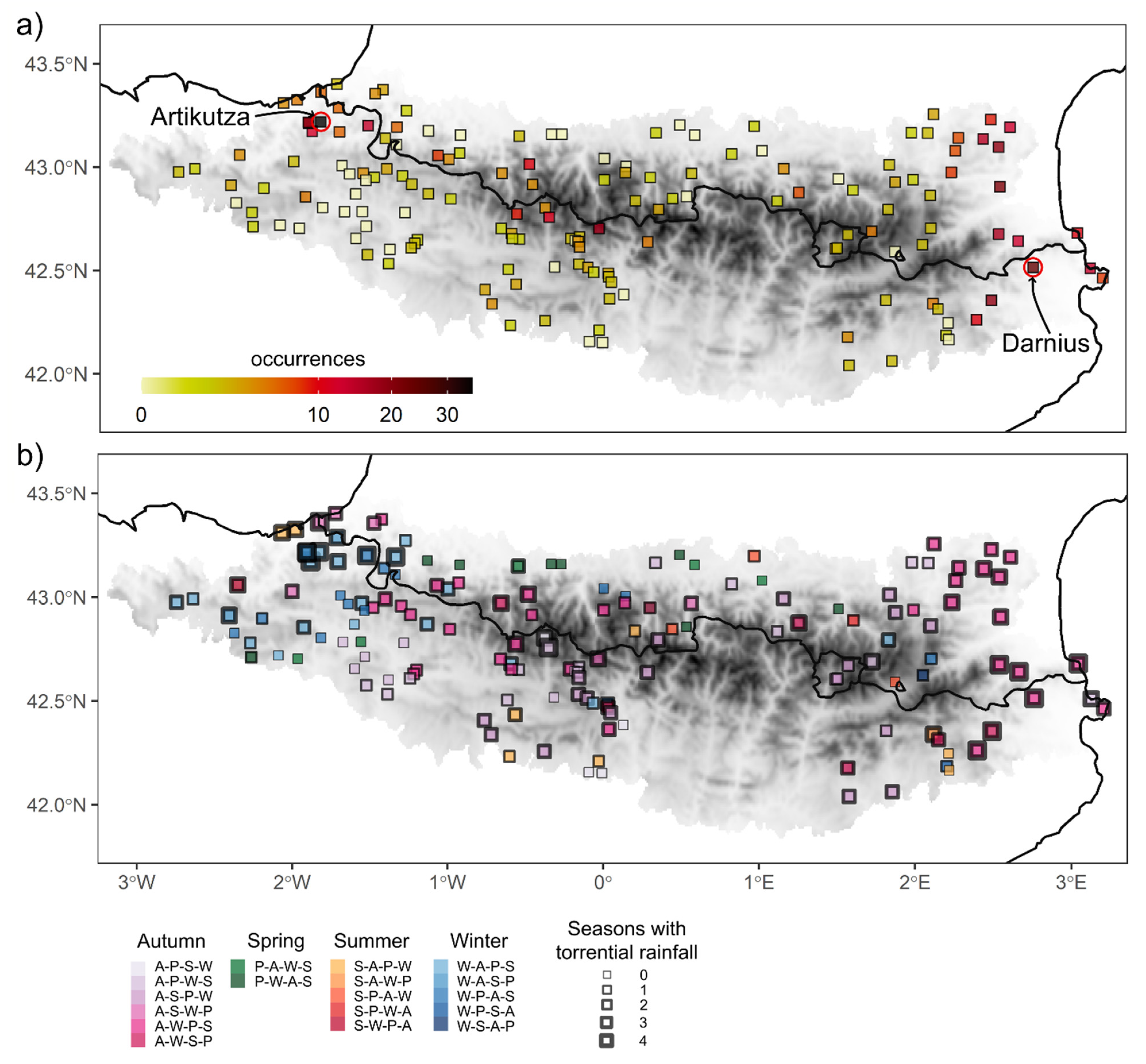
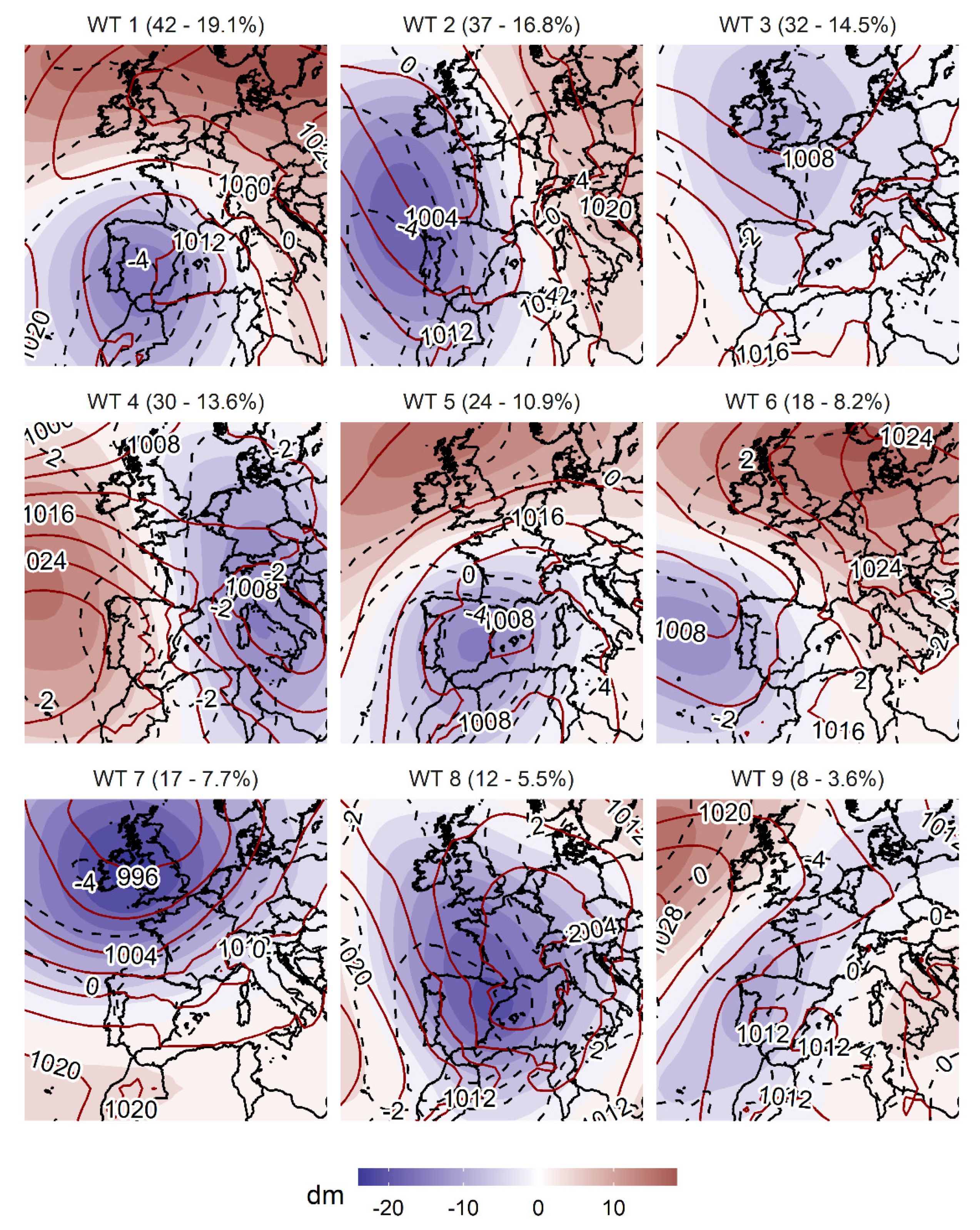
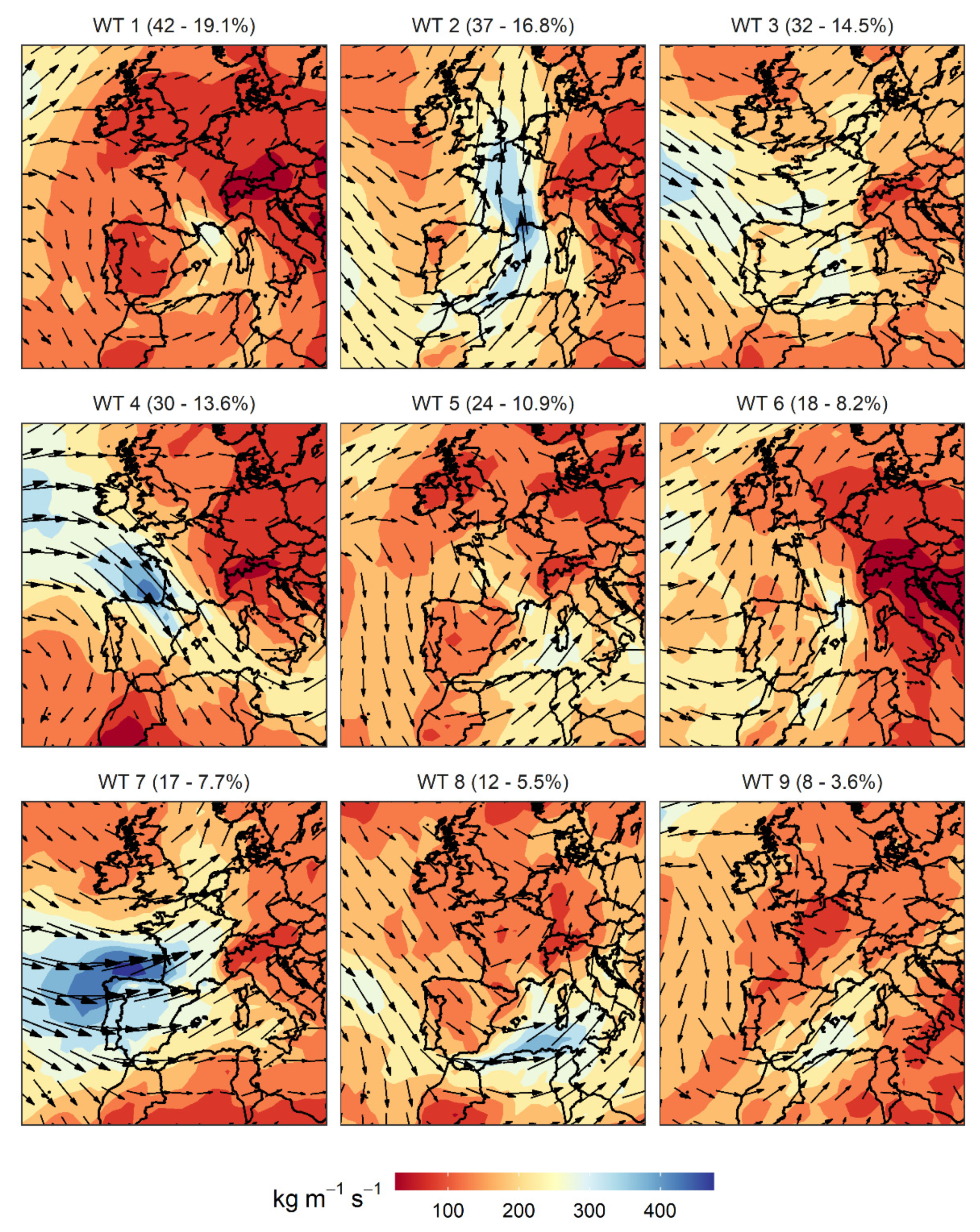
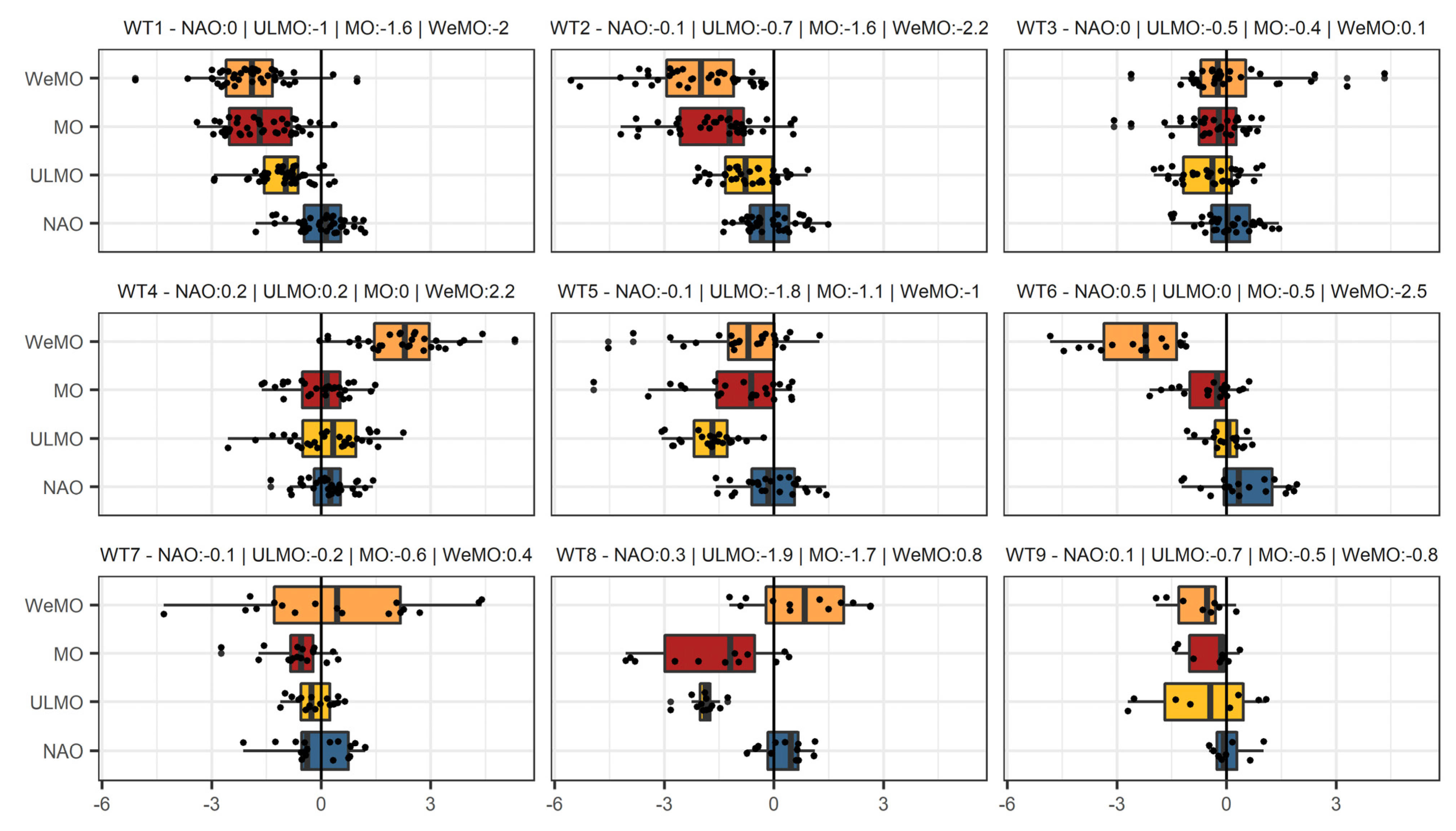
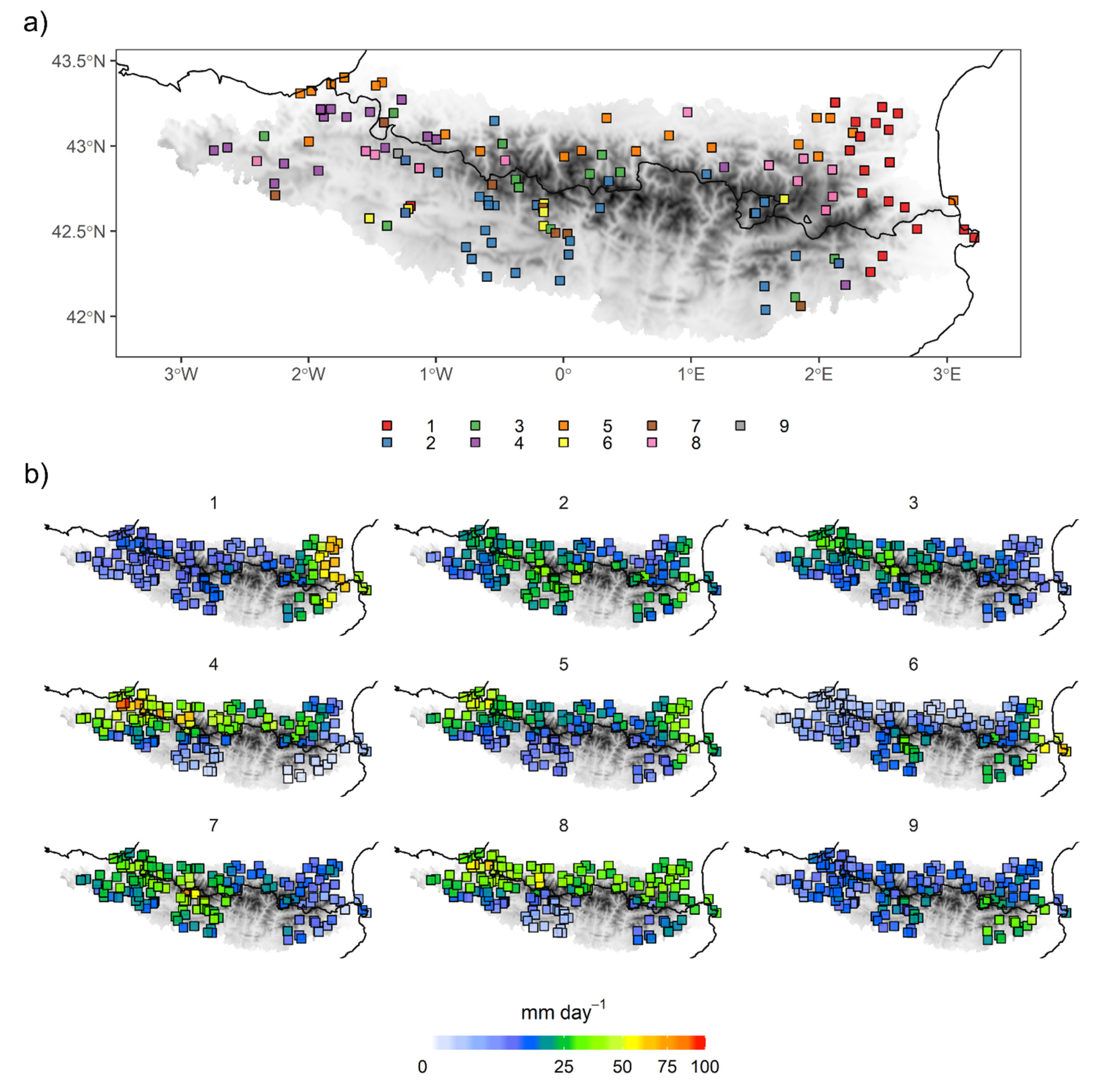
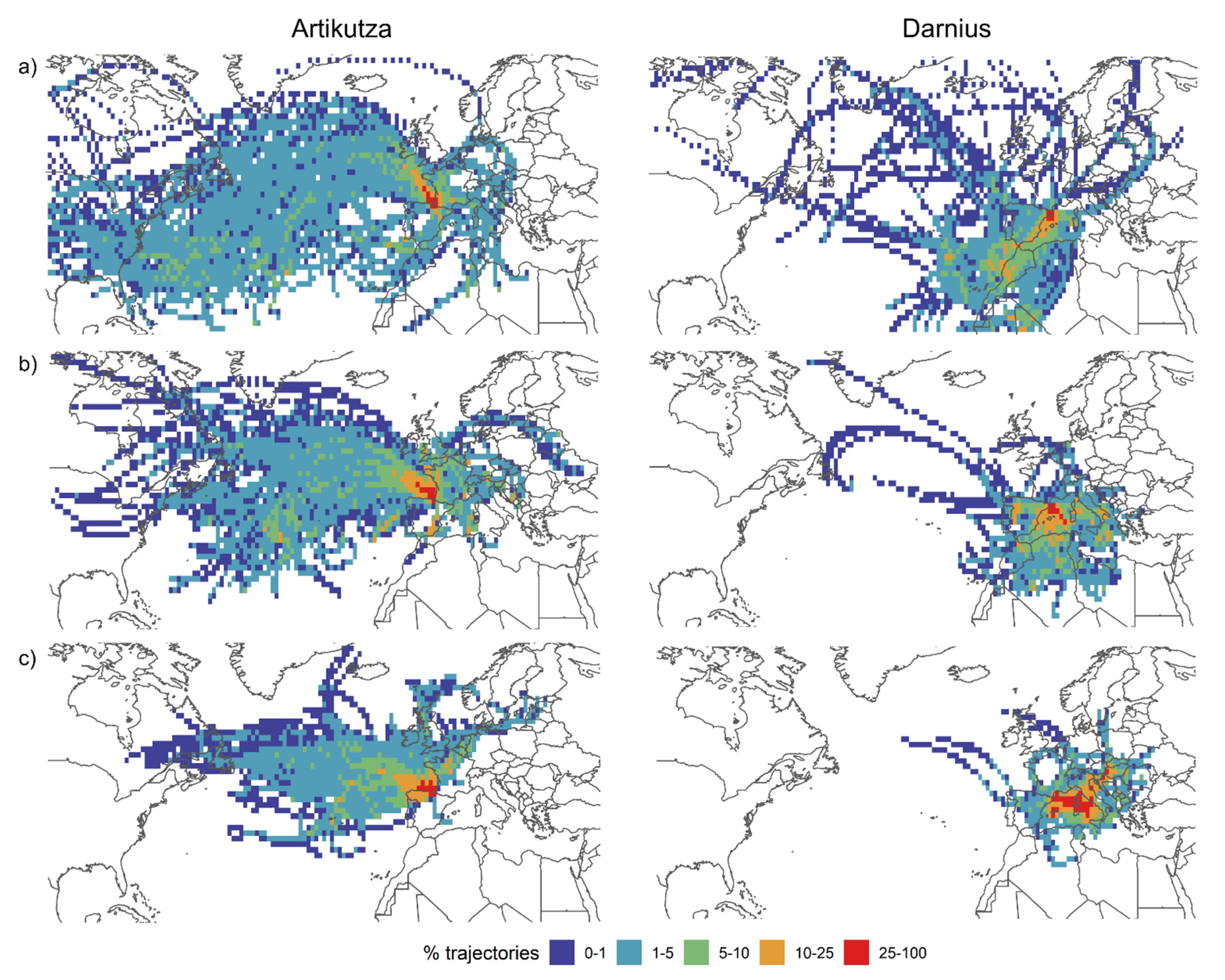
Publisher’s Note: MDPI stays neutral with regard to jurisdictional claims in published maps and institutional affiliations. |
© 2021 by the authors. Licensee MDPI, Basel, Switzerland. This article is an open access article distributed under the terms and conditions of the Creative Commons Attribution (CC BY) license (https://creativecommons.org/licenses/by/4.0/).
Share and Cite
Lemus-Canovas, M.; Lopez-Bustins, J.A.; Martín-Vide, J.; Halifa-Marin, A.; Insua-Costa, D.; Martinez-Artigas, J.; Trapero, L.; Serrano-Notivoli, R.; Cuadrat, J.M. Characterisation of Extreme Precipitation Events in the Pyrenees: From the Local to the Synoptic Scale. Atmosphere 2021, 12, 665. https://doi.org/10.3390/atmos12060665
Lemus-Canovas M, Lopez-Bustins JA, Martín-Vide J, Halifa-Marin A, Insua-Costa D, Martinez-Artigas J, Trapero L, Serrano-Notivoli R, Cuadrat JM. Characterisation of Extreme Precipitation Events in the Pyrenees: From the Local to the Synoptic Scale. Atmosphere. 2021; 12(6):665. https://doi.org/10.3390/atmos12060665
Chicago/Turabian StyleLemus-Canovas, Marc, Joan Albert Lopez-Bustins, Javier Martín-Vide, Amar Halifa-Marin, Damián Insua-Costa, Joan Martinez-Artigas, Laura Trapero, Roberto Serrano-Notivoli, and José María Cuadrat. 2021. "Characterisation of Extreme Precipitation Events in the Pyrenees: From the Local to the Synoptic Scale" Atmosphere 12, no. 6: 665. https://doi.org/10.3390/atmos12060665
APA StyleLemus-Canovas, M., Lopez-Bustins, J. A., Martín-Vide, J., Halifa-Marin, A., Insua-Costa, D., Martinez-Artigas, J., Trapero, L., Serrano-Notivoli, R., & Cuadrat, J. M. (2021). Characterisation of Extreme Precipitation Events in the Pyrenees: From the Local to the Synoptic Scale. Atmosphere, 12(6), 665. https://doi.org/10.3390/atmos12060665





